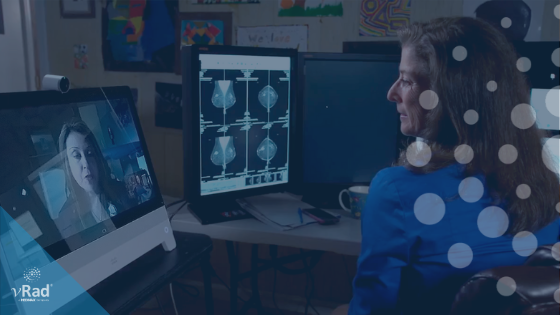I See AI Improving Care for Stroke Victims Every Day
For the latest information on vRad’s Artificial Intelligence program please visit vrad.com/radiology-services/radiology-ai/ vRad AI models are at...

Remote radiologist jobs with flexible schedules, equitable pay, and the most advanced reading platform. Discover teleradiology at vRad.

Radiologist well-being matters. Explore how vRad takes action to prevent burnout with expert-led, confidential support through our partnership with VITAL WorkLife. Helping radiologists thrive.

Visit the vRad Blog for radiologist experiences at vRad, career resources, and more.

vRad provides radiology residents and fellows free radiology education resources for ABR boards, noon lectures, and CME.

Teleradiology services leader since 2001. See how vRad AI is helping deliver faster, higher-quality care for 50,000+ critical patients each year.

Subspecialist care for the women in your community. 48-hour screenings. 1-hour diagnostics. Comprehensive compliance and inspection support.

vRad’s stroke protocol auto-assigns stroke cases to the top of all available radiologists’ worklists, with requirements to be read next.

vRad’s unique teleradiology workflow for trauma studies delivers consistently fast turnaround times—even during periods of high volume.

vRad’s Operations Center is the central hub that ensures imaging studies and communications are handled efficiently and swiftly.

vRad is delivering faster radiology turnaround times for 40,000+ critical patients annually, using four unique strategies, including AI.
.jpg?width=1024&height=576&name=vRad-High-Quality-Patient-Care-1024x576%20(1).jpg)
vRad is developing and using AI to improve radiology quality assurance and reduce medical malpractice risk.

Now you can power your practice with the same fully integrated technology and support ecosystem we use. The vRad Platform.

Since developing and launching our first model in 2015, vRad has been at the forefront of AI in radiology.

Since 2010, vRad Radiology Education has provided high-quality radiology CME. Open to all radiologists, these 15-minute online modules are a convenient way to stay up to date on practical radiology topics.

Join vRad’s annual spring CME conference featuring top speakers and practical radiology topics.

vRad provides radiology residents and fellows free radiology education resources for ABR boards, noon lectures, and CME.

Academically oriented radiologists love practicing at vRad too. Check out the research published by vRad radiologists and team members.

Learn how vRad revolutionized radiology and has been at the forefront of innovation since 2001.

%20(2).jpg?width=1008&height=755&name=Copy%20of%20Mega%20Nav%20Images%202025%20(1008%20x%20755%20px)%20(2).jpg)

Visit the vRad blog for radiologist experiences at vRad, career resources, and more.


Explore our practice’s reading platform, breast imaging program, AI, and more. Plus, hear from vRad radiologists about what it’s like to practice at vRad.

Ready to be part of something meaningful? Explore team member careers at vRad.
2 min read
Rick Jennings : August 17, 2011

I had the opportunity to participate in the Institute for Health Technology Transformation (iHT2) conference on mHealth in Seattle yesterday. The core theme for this iHT2 conference was all about use of mobile solutions on smart phones, tablets, and other devices in the health care world.
Physicians Want Mobile Access The one overriding take away for me was that demand from physicians AND patients for mobile access to health care information is driving a frenzy of discussions, prototypes, and yes, real production strength system. Physicians in particular are demanding access to their systems via the mobile tools
pervading all other parts of their lives. They are asking questions like, “Why do I have to go find a desktop to get this information?” or “You want to get my email, text messages, and phone calls on this device, why can’t you let me get to the information so I can RESPOND and do my job?”
Patient Record App I was very impressed with the Palomar Pomerado Health systems’ mHealth application. Dr. Ben Kantor, Chief Medical Information Officer, and Orland Portale, Chief Innovation Officer, showed me their Android-based patient record application. This very cool app enables a physician to see a patient’s record, recent test results such as EKG or radiology, and enables video-based communication. Pomerado selected CISCO’s new Android-based tablet not only due to its compact form factor, pervasiveness of the operating system, but also based on the reasoning that CISCO is an enterprise-product company and the tablet has arrived.
Teleburn Services Another amazing example showing how very common technology coupled with some smart management can address the “technology deficit” in health care. Lehigh Valley Health Services is a leader in telehealth services and I had a chance to talk to Joe Tracy, VP of TeleHealth Services. Joe lead the development of a very successful teleBurn service that combined mobile-based communication with JPEG based digital imagery to allow a remote burn surgeon to readily provide patient care information to an attending physician. Simple, effective, and it made a HUGE impact. Joe said instead of routinely life-flighting patients to the major burn center, a significant number of patients stayed put at the remote facility and received the same level of care FASTER. Clearly, providing better patient results and saving significant money.
Ways to Meet Technology Demands As technology managers, we have to meet this demand for mobile solutions. If we don’t, our clients will find a way around us and then “give us” a solution to maintenance. So, find out if your electronic medical record (EMR) vendor is planning a mobile solution. If not, demand it. If it is in the works, offer to beta test it. If you don’t have an EMR, think about gathering a small, fast moving team to put together some simple physician information apps on an Android or Apple device SOON. Start small with simple items like calendars, schedules, and simple patient history. Ask what the 3 most important information elements your clients need via mobile and try to get at least ONE of them fast. This will show your clients you are responding and this first small step could be the “tipping point” to get a much more pervasive mHealth solution going.
How are you working to keep up with the latest in mobile healthcare?
-Rick Jennings, vRad Chief Technology Officer
Back to Blog-1.png)
For the latest information on vRad’s Artificial Intelligence program please visit vrad.com/radiology-services/radiology-ai/ vRad AI models are at...

At the foundation of everything we do at vRad is the goal of helping our clients provide the highest level of patient care regardless of the time and...
.png)
I’ll be honest, I had no plans to go into teleradiology straight from residency. However, I fell into it because economic conditions meant choices...
vRad (Virtual Radiologic) is a national radiology practice combining clinical excellence with cutting-edge technology development. Each year, we bring exceptional radiology care to millions of patients and empower healthcare providers with technology-driven solutions.
Non-Clinical Inquiries (Total Free):
800.737.0610
Outside U.S.:
011.1.952.595.1111
3600 Minnesota Drive, Suite 800
Edina, MN 55435